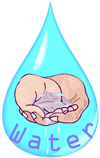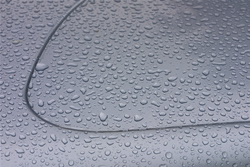Biology: Chemistry of Life: Part Three
Water and Solutions: Water and Living Things

Earth is the water planet. Four-fifths of our planet’s surface is covered in water. Scientists have theorized that life began in water and only much later made the transition to land.
Water is the universal solvent. Given enough time, water will even destroy the tallest mountain. Water causes floods that kill thousands of people annually, yet it is essential for life to exist. Did you know that 70 percent of your body is made up of water? Certain properties of water make it an important substance for life. Some of these properties include:
- Energy Storage: Water absorbs heat and retains this energy for a long period of time. Thus, living things warm up and cool off slowly because they contain so much water.
- Cohesion: Water molecules are attracted to each other and are held together by hydrogen bonds. Large numbers of these very weak bonds give water great interconnectivity. Water’s tendency to attract itself causes it to bead up on a freshly-waxed automobile hood and allows it to support the weight of water striders and other insects walking across its surface.

- Adhesion: Water molecules are also attracted to other polar molecules. The attraction between different substances is called adhesion.
- Polarity: Water is often called the universal solvent. The polarity of water allows many substances to dissolve in it. Ionic compounds (like NaCl) and polar molecules (like alcohol) dissolve easily in water. However, a non-polar substance such as oil will not dissolve in water. How does water dissolve something? When sodium chloride (NaCl) is added to water, the oppositely charged ends of many water molecules surround the sodium ions (Na+) or chloride ions (Cl-) in the compound. The overall effect of the attractions between the water molecules and the ions is enough to break the ionic bonds that hold the compound together. Since living things are composed of atoms and molecules in aqueous solutions (solutions that have materials dissolved in water), water’s ability to dissolve materials is critically important to life’s chemical processes.
 Make a list of some common things in your house, and try to predict if water will dissolve them. NOTE: Do not throw anything into water; this is a thought experiment! Research on the Internet and see if your guesses are correct. Make a list of some common things in your house, and try to predict if water will dissolve them. NOTE: Do not throw anything into water; this is a thought experiment! Research on the Internet and see if your guesses are correct.
 Complete this crossword puzzle to practice what you've learned so far. Complete this crossword puzzle to practice what you've learned so far.
Now go on to the next part. 
| 